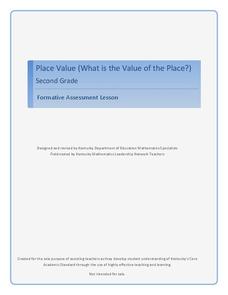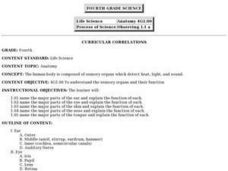Broward County Public Schools
Force and Motion
Get the ball rolling with this upper-elementary science unit on forces and motion. Offering over three weeks of physical science lessons, this resource is a great way to engage the class in learning about simple machines, friction,...
Kentucky Department of Education
Multi-Digit Multiplication Strategies
There is more than one way to solve a multiplication problem, and many learners find that the lattice multiplication method can be a helpful one. Fourth graders take an initial formative assessment before working in groups of two or...
GeorgiaStandards.org
Family and Friends
Build your own Spanish unit about family and friends with these assessments and activities! Included here are several summative assessments to choose from and many activity ideas, cross-curricular tasks, and formative assessments...
Curated OER
Place Value - What Is the Value of the Place?
Second graders build number sense in an activity that requires the matching of base 10 representations to numbers. It is the teachers responsibility to gauge student understanding and involvement while class members work in groups.
California Department of Education
Consonance and Dissonance: Creating Intervals for Emotions (CTE)
How are music and emotion related? Using lesson plan two of four from the Changing One's Tune: A Music Therapy STEM Integrated Project Series, scholars explore the connection between the two topics. They learn to recognize different...
Curated OER
Give Me Five A Day!
Students engage in a lesson lead by the teacher to discover the diet plan of increasing the consumption of fruits and vegetables. They conduct discussions in class with each other, at home with parents, and in the community if possible.
Curated OER
Anatomy
Fourth graders describe how health behaviors affect body systems, and describe the basic function of major body systems.
Curated OER
Anatomy
Second graders identify the major organs of the body and their primary function, identify major systems of the body, and describe behaviors that protect the body structure and organs.
Curated OER
Anatomy
Third graders explore the basic structures and functions of the human body and how they relate to personal health.
Curated OER
Anatomy
Fifth graders identify and describe the functions of the major body systems. They discover how to maintain a healthy lifestyle with proper nutrition and exercise. They answer comprehension questions to end the lesson.
Curated OER
Investigating Nontraditional Occupations
High schoolers identify career areas that are nontraditional for their gender. They identify women (or men if they are underrepresented) who are leaders and achievers in the particular core content curriculum area.
Curated OER
Wild Or Domestic?
Students discuss differences between wild and domestic animals. They list animals on chart paper, and then cut out pictures from magazines to create large collage showing wild and domestic animals.
Curated OER
Word Scramble – Lesson 3
In this health activity, middle schoolers identify and define vocabulary terms related to foodborne illness. They unscramble the words listed at the bottom of the sheet and use them to complete each of 8 blanks.
Curated OER
How Did That Get There?
Students evaluate the role of government in addressing land use and other environmental issues. They analyze the powers, responsibilities, and limitations of elected and appointed officials in the national legislative, executive, and...
Curated OER
Educated Action
Young scholars review what they already know about birds. Using the internet, they discover major issues involved with birds in Illinois. In groups, they determine what they can do to help them and contact a local agency.
Curated OER
Reservoir Activity
Students research the economic importance of the major reservoirs in Illinois. In groups, they manage a budget for one of the lakes to promote tourism in the area. They also work together to create advertisements.
Other popular searches
- Department of State
- Us State Department
- Vietnam State Department
- State Department Briefing
- U.s. State Department















